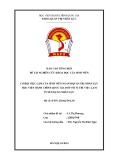
This Provisional PDF corresponds to the article as it appeared upon acceptance. Fully formatted
PDF and full text (HTML) versions will be made available soon.
A comparative study of some methods for color medical images segmentation
EURASIP Journal on Advances in Signal Processing 2011,
2011:128 doi:10.1186/1687-6180-2011-128
Liana Stanescu (stanescu@software.ucv.ro)
Dumitru Dan Burdescu (dburdescu@software.ucv.ro)
Marius Brezovan (mbrezovan@software.ucv.ro)
ISSN 1687-6180
Article type Research
Submission date 15 May 2011
Acceptance date 9 December 2011
Publication date 9 December 2011
Article URL http://asp.eurasipjournals.com/content/2011/1/128
This peer-reviewed article was published immediately upon acceptance. It can be downloaded,
printed and distributed freely for any purposes (see copyright notice below).
For information about publishing your research in EURASIP Journal on Advances in Signal
Processing go to
http://asp.eurasipjournals.com/authors/instructions/
For information about other SpringerOpen publications go to
http://www.springeropen.com
EURASIP Journal on Advances
in Signal Processing
© 2011 Stanescu et al. ; licensee Springer.
This is an open access article distributed under the terms of the Creative Commons Attribution License (http://creativecommons.org/licenses/by/2.0),
which permits unrestricted use, distribution, and reproduction in any medium, provided the original work is properly cited.

A comparative study of some methods for color medical
images segmentation
Liana Stanescu∗, Dumitru Dan Burdescu
and Marius Brezovan
Faculty of Automation, Computers
and Electronics, University of Craiova,
200440, Romania
∗Corresponding author:
stanescu@software.ucv.ro
Email addresses:
DDB: dburdescu@software.ucv.ro
MB: mbrezovan@software.ucv.ro
Abstract The aim of this article is to study the problem of color medical im-
ages segmentation. The images represent pathologies of the digestive tract such
as ulcer, polyps, esophagites, colitis, or ulcerous tumors, gathered with the help
of an endoscope. This article presents the results of an objective and quanti-
tative study of three segmentation algorithms. Two of them are well known:
the color set back-projection algorithm and the local variation algorithm. The

2
third method chosen is our original visual feature-based algorithm. It uses a
graph constructed on a hexagonal structure containing half of the image pix-
els in order to determine a forest of maximum spanning trees for connected
component representing visual objects. This third method is a superior one
taking into consideration the obtained results and temporal complexity. These
three methods were successfully used in generic color images segmentation.
In order to evaluate these segmentation algorithms, we used error measuring
methods that quantify the consistency between them. These measures allow a
principled comparison between segmentation results on different images, with
differing numbers of regions generated by different algorithms with different
parameters.
Keywords: graph-based segmentation; color segmentation; segmentation eval-
uation; error measures.
1 Introduction
The problem of partitioning images into homogenous regions or semantic en-
tities is a basic problem for identifying relevant objects. Some of the practi-
cal applications of image segmentation are medical imaging, locate objects in
satellite images (roads, forests, etc.), face recognition, fingerprint recognition,
traffic control systems, visual information retrieval, or machine vision.
Segmentation of medical images is the task of partitioning the data into
contiguous regions representing individual anatomical objects. This task is vi-
tal in many biomedical imaging applications such as the quantification of tissue

3
volumes, diagnosis, localization of pathology, study of anatomical structure,
treatment planning, partial volume correction of functional imaging data, and
computer-integrated surgery [1,2].
This article presents the results of an objective and quantitative study of
three segmentation algorithms.
Two of them are already well known:
–The color set back-projection; this method was implemented and tested on
a wide variety of images including medical images and has achieved good
results in automated detection of color regions (CS).
–An efficient graph-based image segmentation algorithm known also as the
local variation algorithm (LV)
The third method design by us is an original visual feature-based algo-
rithm that uses a graph constructed on a hexagonal structure (HS) containing
half of the image pixels in order to determine a forest of maximum spanning
trees for connected component representing visual objects. Thus, the image
segmentation is treated as a graph partitioning problem.
The novelty of our contribution concerns the HS used in the unified frame-
work for image segmentation and the using of maximum spanning trees for
determining the set of nodes representing the connected components.
According to medical specialists most of digestive tract diseases imply ma-
jor changes in color and less in texture of the affected tissues. This is the reason
why we have chosen to do a research of some algorithms that realize images
segmentation based on color feature.

4
Experiments were made on color medical images representing pathologies
of the digestive tract. The purpose of this article is to find the best method
for the segmentation of these images.
The accuracy of an algorithm in creating segmentation is the degree to
which the segmentation corresponds to the true segmentation, and so the
assessment of accuracy of segmentation requires a reference standard, repre-
senting the true segmentation, against which it may be compared. An ideal
reference standard for image segmentation would be known to high accuracy
and would reflect the characteristics of segmentation problems encountered in
practice [3].
Thus, the segmentation algorithms were evaluated through objective com-
parison of their segmentation results with manual segmentations. A medical
expert made the manual segmentation and identified objects in the image due
to his knowledge about typical shape and image data characteristics. This
manual segmentation can be considerate as “ground truth”.
The evaluation of these three segmentation algorithms is based on two
metrics defined by Martin et al.: Global Consistency Error (GCE), and Local
Consistency Error (LCE) [4]. These measures operate by computing the degree
of overlap between clusters or the cluster associated with each pixel in one
segmentation and its “closest” approximation in the other segmentation. GCE
and LCE metrics allow labeling refinement in either one or both directions,
respectively.




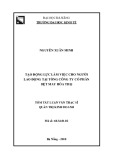
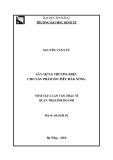

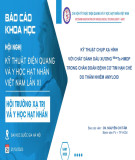
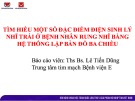
![Hình ảnh học bệnh não mạch máu nhỏ: Báo cáo [Năm]](https://cdn.tailieu.vn/images/document/thumbnail/2024/20240705/sanhobien01/135x160/1985290001.jpg)
